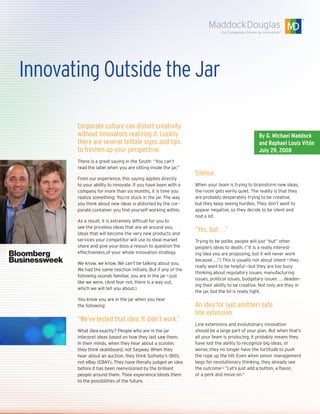
Bw Innovating Outside The Jar
- 1. Innovating Outside the Jar Corporate culture can distort creativity without innovators realizing it. Luckily By G. Michael Maddock there are several telltale signs and tips and Raphael Louis Vitón to freshen up your perspective. July 29, 2008 There is a great saying in the South: “You can’t read the label when you are sitting inside the jar.” Silence. From our experience, this saying applies directly to your ability to innovate. If you have been with a When your team is trying to brainstorm new ideas, company for more than six months, it is time you the room gets eerily quiet. The reality is that they realize something: You’re stuck in the jar. The way are probably desperately trying to be creative, you think about new ideas is distorted by the cor- but they keep seeing hurdles. They don’t want to porate container you find yourself working within. appear negative, so they decide to be silent and nod a lot. As a result, it is extremely difficult for you to see the priceless ideas that are all around you, ideas that will become the very new products and “Yes, but . . .” services your competitor will use to steal market Trying to be polite, people will just “but” other share and give your boss a reason to question the people’s ideas to death. (“It is a really interest- effectiveness of your whole innovation strategy. ing idea you are proposing, but it will never work because . . .”) This is usually not about intent — they We know, we know. We can’t be talking about you. really want to be helpful — but they are too busy We had the same reaction initially. But if any of the thinking about regulatory issues, manufacturing following sounds familiar, you are in the jar — just issues, political issues, budgetary issues . . . deaden- like we were. (And fear not, there is a way out, ing their ability to be creative. Not only are they in which we will tell you about.) the jar, but the lid is really tight. You know you are in the jar when you hear the following: An idea for (yet another) safe line extension. “We’ve tested that idea. It didn’t work.” Line extensions and evolutionary innovation What idea exactly? People who are in the jar should be a large part of your plan. But when that’s interpret ideas based on how they last saw them. all your team is producing, it probably means they In their minds, when they hear about a scooter, have lost the ability to recognize big ideas, or they think skateboard, not Segway. When they worse, they no longer have the fortitude to push hear about an auction, they think Sotheby’s (BID), the rope up the hill. Even when senior management not eBay (EBAY). They have literally judged an idea begs for revolutionary thinking, they already see before it has been reenvisioned by the brilliant the outcome — ”Let’s just add a button, a flavor, people around them. Their experience blinds them or a perk and move on.” to the possibilities of the future.
- 2. “Huh?” If you are often asked by really smart consultants or newcomers to your company what in God’s name you are talking about, you’re probably in the jar. Seems that after a few months in the jar together, we develop our own language. Often laced with industry-borne acronyms, this strange way of Ever notice how a five-year-old can walk into a situ- communicating seeps into our customer and client ation and ask an innocent question that elicits the communications. These industry clichés keep our “because that’s the way we do it” response? Then customers from recognizing great innovation. you realize you’ve never really questioned why you A few years back we scored big points with about do it that way? Five-year-olds are too young to be 40 million customers when we convinced a client to in the jar. change the last line on its monthly billing statement So are you. from “Account Balance” to “What you owe.” You are surrounded by hundreds of similar examples. G. Michael Maddock is chief executive, and Raphael At the root of Zen philosophy is the ability to Louis Vitón is president of Maddock Douglas, an objectify your situation, to be able to step outside innovation consultancy that helps clients invent, your situation and see it for what it really is — warts brand and launch new products, services and business and all. So now that you see yourself in the jar, models. Maddock is author of the upcoming book Brand New: Solving the Innovation Paradox — what do you do about it? How Great Brands Invent and Launch New Products, Services and Business Models (Wiley, April 2011). Following are three simple tips: 1. et experts from outside your industry to G help you stay honest and see what is happening outside the jar. 2. et outside your office and act like an G Mike Maddock, CEO anthropologist. Spend time with your customer mike@maddockdouglas.com and bring an expert interpreter and a couple 630.563.6415 members of your team. Compare notes; you will be shocked at how differently you all see the situation. 3. e very careful about the language you use. B In this case, “voice of the customer” should be taken literally. Customers recognize, respond to, and build from their own words more than yours. So use their language when exploring insights, writing concepts and introducing new products.
